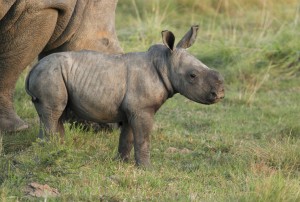 < Baby rhino at Kariega Game Reserve[/caption]In the 1950s White Rhino were in danger of becoming extinct and through a concerted effort by Dr Ian Player and a dedicated team of people this iconic species was brought back from the brink of extinction - "In the late 1950s we faced the challenge of the White Rhino becoming extinct. We overcame the technical and political problems and from a small number of 437 White Rhino in 1953, there are now thousands in the world. A small team of dedicated people made the difference." Dr Ian Player DMS
In the 1960s there were over a million Black Rhino, but by the 1980s the world's Black Rhino population had become seriously endangered. To raise awareness about the plight of the Black Rhino and help bring the species back from the brink of extinction, two deeply committed young Zimbabweans, Julie Edwards and Charlene Hewat, undertook a "Ride for the Rhino" campaign, a gruelling 18-month cycle of 22 000 kilometres from Glasgow to Harare. They later wrote a book titled Extinction is Forever in which they described this mammoth effort to “defend the undefended and secure for the vulnerable invulnerability.
< Baby rhino at Kariega Game Reserve[/caption]In the 1950s White Rhino were in danger of becoming extinct and through a concerted effort by Dr Ian Player and a dedicated team of people this iconic species was brought back from the brink of extinction - "In the late 1950s we faced the challenge of the White Rhino becoming extinct. We overcame the technical and political problems and from a small number of 437 White Rhino in 1953, there are now thousands in the world. A small team of dedicated people made the difference." Dr Ian Player DMS
In the 1960s there were over a million Black Rhino, but by the 1980s the world's Black Rhino population had become seriously endangered. To raise awareness about the plight of the Black Rhino and help bring the species back from the brink of extinction, two deeply committed young Zimbabweans, Julie Edwards and Charlene Hewat, undertook a "Ride for the Rhino" campaign, a gruelling 18-month cycle of 22 000 kilometres from Glasgow to Harare. They later wrote a book titled Extinction is Forever in which they described this mammoth effort to “defend the undefended and secure for the vulnerable invulnerability.
Rhinos in Africa and India are again under serious threat from poaching and again it is a relatively small group of people who are working to make a difference, often putting their lives on the line. On this World Ranger Day 2014 I honour the men and women who are working to save rhino and other species under threat, 27 of whom lost their lives in the line of duty in the last 12 months.
